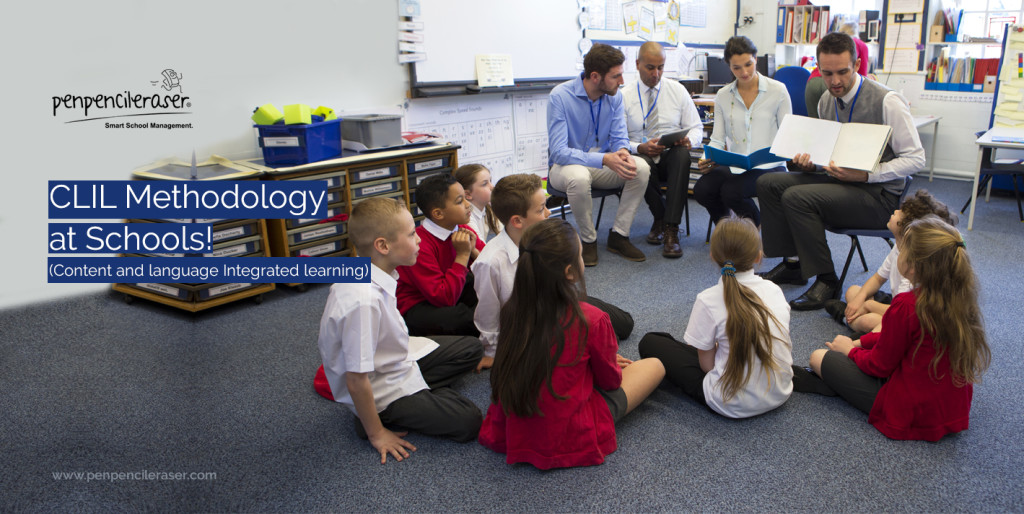The Content and Language Integrated Learning refers to the overall development of the students. The focus is on both the context and the language and when the subject is specifically in a different language which gets excelled and both the language and the content gets accommodated giving a better and beneficial platform to the students.
Having examined over the concept the dual focus instruction is meant to be a revolutionary change as it develops additional skills in the students. To be clearer on this concept, the classroom teaching is generally implied in the first language of the learners but here it is learning a foreign language. It is not all about learning language but along with the learning of language they work on the content and make sure all the subjects are taught and learnt in the new language. This is the factual reason for the success of the both.
This CLIL (Content and language integrated learning) paves the way to the learning of additional language and not mere sticking to the first language medium of learning. This focus becomes exceedingly accommodative and when the language is being learned with the subject specification it shows great improvements. The recompenses over it are that the language competency been developed. Improves multi-lingual communication skills, the subject gets more interesting to learn it in a different language, advances the students confident level and enriches the motivation. When learning the subject in a different language the ability to think, analyze and reproduce develops right from the beginning.
CLIL develops a welcoming approach!
This concept gradually spread across the globe and many countries internationally adhere this trend to the benefit of the students. This system of education becomes suitable for all grades and in simple the knowledge enhancement is dual in the span of learning one subject. The power of learning a new language comes naturally with no different or dedicated time for it, for the simple reason when the subject must be learned for understanding, learning and reproducing the language must be made familiar and hence the learning process seems to be quick and easy. There are schools which adapt the concept partially and when the school is backed with the right teachers and mentors it is all the simpler.
More specifically the benefits of CLIL is that it prepares the students for the internationalization which is important for higher studies and work life as well, creates and develops a unique interest in the multilingual and henceforth stays motivated. All these ultimately accelerate the school profile and takes pride in the success of each student.
The Role of Teachers and Mentors:
At this point in CLIL concept, the subjects and the curriculum serves as a tool for learning the new language. As the target of teachers been to prepare the teaching in the new language means much of strategies involved and the right side by side exposure is obligatory. The class lesson plan should also be planned way in advance in the target language, to improve the vocabulary, the provide the complete learning skills. To this implementation, the right meaning of the works in different contextual is much more required. In most cases, they then to work on their skills of language reading, writing, speaking and presenting. The cultural enhancements with the interconnectivity are been experienced.
What as Teachers need to understand?
Teachers involved in the CLIL should aim to distinguish their teaching from the conventional methods. It is not about schools or regulations, it works best on passion.
The teachers should understand:
- It is not any kind of scheme or rules in CLIL.
- It is also not all about language.
- CLIL is not about aiming the learner to be fluent in the language.
- CLIL is entirely about Dual-focused education as deliberated above.
- It works best in Team Efforts.
- CLIL is not something impossible.
- CLIL can do wonders when applied innovatively.
The Challenges:
Primarily English is the extensively chosen medium and the instruction methodology is been existing for years while the new era system CLIL getting popular would be difficult in meeting the possibilities and the parameters. The language teacher would not be strong in the context subjects while the subject teachers will not be efficient enough in the language. So, this method calls for the integration and the blend of both the subject and the language teachers to make it successful. Still, the adoption of English the universal language teaching cannot be forgone and needs to be in practice as the new language teaching being in many socio, cultural issues.
Another controversy experienced is that the certified subject teachers, when handled the CLIL methodology, does not reach the expectations as they are not skilled in the language meticulously and the vice versa also face the efficiency issue. The teacher’s skill enhancement becomes primary while adopting the CLIL methodology.
How Schools Practice CLIL!
CLIL is effectively practiced in Germany, Italy and they show the professional development in everyday teaching and learning. As this concept was promoted by the European Union with the inspiration of introducing innovative teaching with a foreign language together with the effective content learning.
Schools need to implement the 4C’s – the Content, the Communication, the Cognitive ability and the Culture.
The content is the depth of the subjects to learn like History, Geography, Science, Math’s, etc.
The communication involves the familiarity and the use of language in both the oral and written form.
The cognitive ability is the mental aptitude where the students are trained to think and respond in other language.
The culture is the exploration of the other languages and their experience.
Schools essential is to support and train teachers to learn strategies, they need to approach using ICT, teachers should be provided with the guidance of partnering for teaching.
Inference:
Constant motivation and encouragement make CLIL implementation a success and an overall progress is experienced with all the stack holders-the school, teachers, and the students. Criticism must be eliminated if the schools wish to globalize and perform distinguished.

